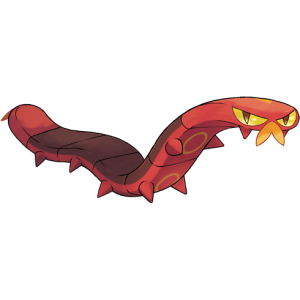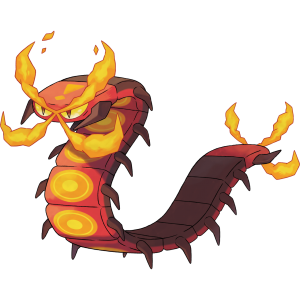In this recurring series, I’ll analyze the origins of Pokémon designs, their culture, and their historical allusions to British culture.
Sizzlipede

Sizzlipede is a Fire and Bug-type Pokémon classified as the Radiator Pokémon. Its name, a combination of “sizzle” and “centipede”, reflects its characteristics.
It is based on a centipede, a bug that is known for having many (but not a hundred) feet. In particular it may be based on a fire centipede, called that for the intense pain of the venom it emits. These centipedes are also known for emitting bioluminescent slime from its pores as a defense mechanism.
It stores flammable gas in its body and uses it to generate heat. The yellow sections on its belly get particularly hot.
It wraps prey up with its heated body, cooking them in its coils. Once they’re well-done, it will voraciously nibble them down to the last morsel.
Sizzlipede is made up of several delineated segments, each with two legs and a yellow circle. Its body does not produce venom but rather flammable gasses that serve mainly as a way to generate body heat. Close contact with prey allows it to cook them. This is a technique that does occur in nature, as Japanese honeybees will use it to kill an invading murder hornet.
Sizzlipede is not the first centipedal Bug-type Pokémon. In fact, others like Skorupi and Venipede have been introduced in previous generations. The Pokédex makes reference to these similarities and the challenges.
After burrowing into the sand, it waits patiently for prey to come near. This Pokémon and Sizzlipede share common descent.
Skorupi
Venipede and Sizzlipede are similar species, but when the two meet, a huge fight ensues.
Venipede
Centiskorch

Sizzlipede levels up into Centiskorch, which grows taller and more intimidating. It goes from having ten legs to twenty. The coils on each segment have now become brighter with more coloration.
This line is based on the concept of a radiator, a utility that emits steam in order to heat a room. It was invented in America but became popular in many countries including England where 93% of homes have radiators.
The radiator’s popularity really came in the 1920s, following the influenza pandemic. At the time it seemed evident that fresh air was a useful asset in reducing transmission, which was tougher in the cold winter. Radiators were able to produce enough heat to keep an apartment warm with the windows open even during the winter. It still is common in New York City apartments.
When it heats up, its body temperature reaches about 1,500 degrees Fahrenheit. It lashes its body like a whip and launches itself at enemies.
While its burning body is already dangerous on its own, this excessively hostile Pokémon also has large and very sharp fangs.
Like Sizzlipede, it finds itself competing for territory. Its carnivorous nature becomes apparent in Scoliopede’s Pokédex entry.
Scolipede engage in fierce territorial battles with Centiskorch. At the end of one of these battles, the victor makes a meal of the loser.
Scoliopede
Gigantamax Centiskorch

When it Gigantamaxes it becomes very long, stretching out to over 246 feet. It has at least a hundred feet, although it is a bit hard to count based on the image. In this form its heating capabilities reach their zenith and its fiery gasses can’t be helped but emit from its body. The intensity of the heat ends up affecting the local atmospheric conditions.
Gigantamax energy has evoked a rise in its body temperature, now reaching over 1,800 degrees Fahrenheit. Its heat waves incinerate its enemies.
The heat that comes off a Gigantamax Centiskorch may destabilize air currents. Sometimes it can even cause storms.
When using a max move, Centiskorch’s body coils up in the form of a radiator, with long vertical pipes that emit heat. It does this when using the move G-Max Centiferno which binds the target in a fire for several turns.
Conclusion
A radiator is a utility that is common in Great Britain, and has become relevant today. Heat tends to attract bugs, and having a radiator centipede provides an interesting addition to the series. Its basis of a centipede is not unique, but it does manage to stand out among its more venomous peers.
Let us know what you think of this unique Bug- and Fire-type line in the comments below or chime in on our Discord server!

